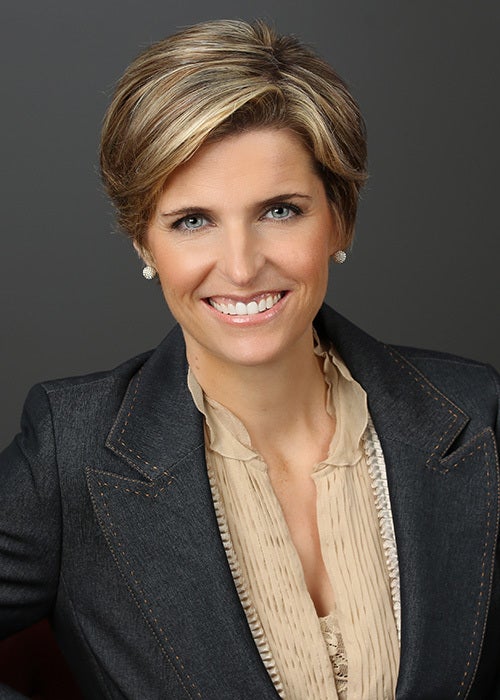
Having a purpose in life provides us with a reason to move forward. The same goes for purpose-driven companies.
Alicia Hare, President of the West Region of consulting firm SYPartners, believes that the key to creating and maintaining a successful company is to build an organization around a purpose.
Alicia’s mission at SYPartners is to help companies, during times of transformation, to understand their true purpose, envision a new and better future, and enable people to bring that future to life. Alicia believes that purpose-driven companies are the most successful and that companies built upon true values with impactful missions are destined for long-term success.

Alicia Hare, President SYPartners West
I had the pleasure of sitting down with Alicia to further discuss how she helps companies and startups survive during times of transformations. Alicia shared her thoughts with me in the Q&A interview below.
Q: How did you come to realize that purpose-driven companies are usually the most successful?
Before joining SYPartners, I worked at 3 iconic companies in 3 different industries that were disrupted-- telecommunications, media and retail. It was through these experiences that I noticed fear was a hallmark feature of being disrupted. The fear of loss and the fear of failure, for example, were very much present in these environments. As a result, I saw a lot of value destroyed and many smart people who were doing great things lose their jobs. After experiencing this happen more than a few times, I took a pause and asked: "Can we do more than just survive in our increasingly uncertain environment?"
I went on a personal exploration to figure this out. The purpose of my exploration was to see if businesses could thrive and also make a positive difference in the world. I eventually discovered that any organization could thrive if they make the choice to do so. The most important choice business leaders have to make is to face their fears and create a better future for the company and those they serve.
This realization helped me to discover how to make these things happen and led me to the work I do today, which is to help companies fight for greatness. The center of all of this was the recognition that everything starts with a purpose. Purpose is required to thrive in the face of disruption. Purpose is what creates a heartbeat and passion. Passion needs to be present not just in our personal lives, but in organizations as well.
Q: What does it look like when a company is in transformation mode?
Startups usually begin with an idea and opportunity, but lack a purpose. Uber is a classic example of a startup with a great idea and product market fit. Yet Uber has now reached a certain size and scale and it’s become apparent that the company is not clear on its real reason for being. A transformation in a case like Uber would start by it uncovering its true purpose.
If you compare Uber to Airbnb - a startup which has the clear purpose of letting people “belong anywhere” - you can see the tale of two startups that have gone from nothing to something significant. Airbnb has been very thoughtful from the beginning though, as the organization has a clear purpose and culture, and has been effective in navigating the big challenges they’ve faced by relying on those central tenets.
All companies have a moment where they have to reconnect to their true purpose. Whether it’s a crisis situation or a leadership change, all organizations experience disruptive moments. What’s helpful during these moments is to have an anchor and to use it to imagine what future they want to create next. This offers the opportunity to move beyond the fear of running out of ideas and puts the company in a position of creativity, activation, and positive impact.
Often, the best purposes are not solely financial. Most companies have this pressure to be number one in the market and hit x-billion dollars at a certain time, yet those aren’t really purposes. The most powerful and enduring purposes are human-centered. Companies must ask themselves, "What do we do to serve humanity? Do we create joy or belonging? Enable exploration or connection?”
Q: What is an external vs. internal expression of purpose?
When purpose is at the center of what you do, both professionally and personally, it should be expressed in everything you or a company does. I think the best expressions of purpose start internally.
Starbucks, for example, has a clear mission to “inspire and nurture the human spirit – one person, one cup and one neighborhood at a time.” The company has over 300,000 partners and they provide healthcare to all their employees, along with a free college education. Starbucks also expresses its mission externally. For example, they are currently trying to hire 10,000 refugees by 2022.
REI is another example of a purpose-driven company. The company is based around the idea of giving people more access to the outdoors. REI’s #OptOutside campaign is meant to encourage people to go outside, rather than shopping on Thanksgiving and Black Friday. They are also targeting greater gender equity for women in the outdoors through telling inspiring stories, closing gaps in gear design, and offering classes. When purpose is at its best it drives everything – both eternally and internally.
Q: What is the best piece of advice you’ve offered an executive seeking transformative change?
Be incredibly intentional about why you want to change. Change can be really tough. There are times when people say they want to change, but have difficulty doing so. You have to dig deep to connect to your “why.”
Purpose provides that answer. The most successful business transformations have a match between the leader’s purpose and the company’s purpose. If these two elements are aligned, then leaders have so much more heart, authenticity and passion when creating a successful company that will continue to thrive.
Q: What are a few exercises business leaders can practice in prepping for transformation?
One of two things always happens when starting a transformation-- either you never had a true purpose and you need to give birth to it, or you have a purpose and need to reconnect to it.
Often, companies with longevity have to reconnect with their purpose. This involves going back to the original reason behind why they were founded. It sometimes helps to speak with the people that have been with the company the longest to uncover the heart and soul of the business.
When companies on the startup side get to a place of hyper growth, there is a moment when the organization needs to pause and think, “What do we really want to contribute?” There is a moment where every company gets to chart their own course. The business goes from moving from product to purpose at that moment.
Q: Describe your experience as a woman leader and managing change.
Leading change is an equal opportunity sport. I’ve had the great privilege of having many experiences that have forced me to adapt to change. I’ve also learned to be very aware of the environments I’ve chosen to work in. I’ve learned that there are places that accept, encourage and support female leadership, and places that don’t.
Personally, I choose to be in places that encourage change and positive impact. When you’ve found the right environment for change, you can do many amazing things.
